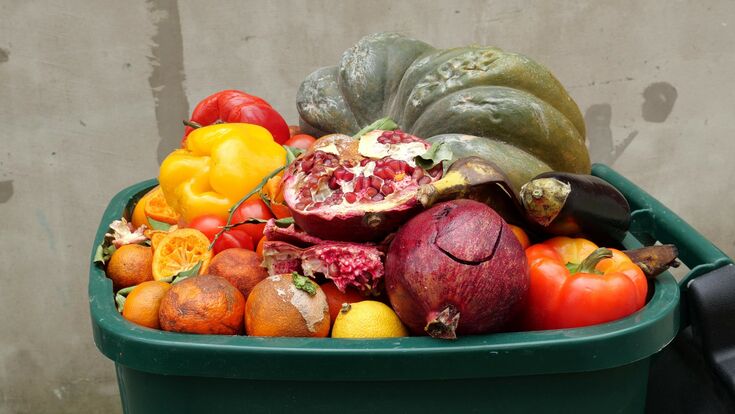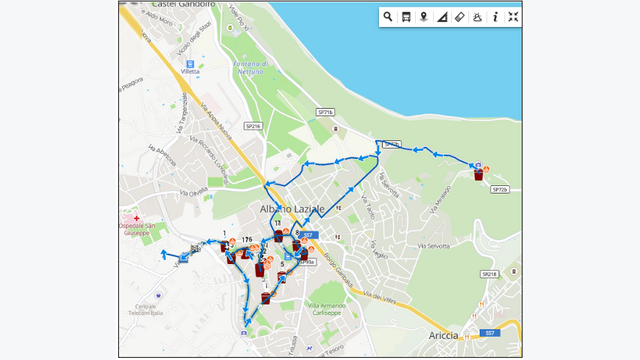Innovative approaches to deal with biowaste : Biowaste collection and valorisation: Problems and solutions

The SCALIBUR project, funded by the EU's research and innovation programme Horizon 2020, has developed innovative solutions to valorize urban organic waste and sewage sludge into high-value-added products, allowing the creation of new circular economy business opportunities
About 225 Mt of municipal solid waste (MSW) has been collected in 2020 in Europe (505 kg per capita). Since only 48% is valorized (30% recycling rate and 18% valorized by composting), 50% is eliminated (27% in waste to energy/incineration plants and 23% landfilled)1.
There is a huge environmental impact associated with the greenhouse gases generated, not to mention the huge economic loss, considering landfill tax cost as well as the value of the different recyclable materials found in MSW (the organic fraction of the municipal solid waste, plastics, paper, metals, and glass).
Considering the average composition of MSW (15.7% paper and cardboard, 5.1% metals, 13% glass, 12.4% plastics, 37.4% organic matter, plus other materials), millions are lost due to the landfilling of MSW in the European Union.
MSW valorization rates are higher in central and northern European countries (around 60%) than in southern and eastern countries (around 20%), where waste collection and treatment infrastructure, as well as environmental awareness, are less developed.
New European legislation and strategies on waste management (Waste Framework Directive 2018/8511, the Flagship initiative roadmap under the Europe 2020, the Circular Economy Action Plan for 2030) set a scale of priorities regarding waste treatment: prevention, re-use, recycling, recovery, and disposal.
About 225 Mt of municipal solid waste (MSW) has been collected in 2020 in Europe (505 kg per capita). But only 48% is valorized (30% recycling rate and 18% valorized by composting)
Three pilot cities
To reach these objectives, the SCALIBUR project has developed and tested several techniques in three pilot cities with the aim of improving the collection, transport, and characterization of the Organic Fraction of Municipal Solid Waste (OFMSW). The selected cities are Madrid in Spain, Albano Laziale in Italy, and Kozani in Greece, which are implementing the following activities:
- Madrid (Spain): in this pilot, social activities, like webinars, have been developed in order to engage people to recycle and raise awareness about the importance of their acts to the global chain of valorization.
- Kozani (Greece): a system has been developed to monitor the OFMSW containers, plan the collection and optimize the route to be followed by the vehicles used in the operation, depending on the filling level of the containers and the state of degradation of the organic matter.
- Albano Laziale (Italy): Similar, to Kozani’s demo, the truck collection routes have also been optimized considering the container filling levels, thus only collecting the proper containers and also optimizing the route in terms of time, fuel, and so on. In this case, the pilot activity was focused on the HORECA sector.
Madrid: Low motivation and lack of knowledge
In Madrid, first, the status of the selective collection within the city was studied, including the baseline analysis, limitations, and current drawbacks of the system, but also new strategies to overcome the problems. In this context, the Biowaste Club of Madrid was created to contemplate and discuss the main problems and solutions within the city, among which were:
Problems:
- Low motivation to recycle.
- Lack of knowledge on how to separate waste.
Solutions:
- Citizens must be seen as the basis of the bio-waste recycling chain.
- To be sustainable, data about the selective collection is needed.
Like what you read? Subscribe to our free newsletters to get regular updates!
In this sense, raising citizen awareness on how to recycle is valuable in order to improve their recycling behavior and ultimately increase the potential for biowaste valorization. To achieve this, activities like awareness-raising campaigns and engagement activities, with clear messages disseminated in several languages to avoid the barrier of the language was carried out.
In addition, there was a need to implement further innovations in the value chain to improve the potential of valorization of urban biowaste:
- Innovation in the sorting of the Organic Fraction of Municipal Solid Waste (OFMSW). A biowaste monitoring system based on optic and spectroscopic cameras for the detection of contaminants within the organic fraction, allowing better separation and attainment of higher quality biowaste
- Innovation in the OFMSW pre-treatment steps for the OFMSW fraction is necessary to avoid the biodegradation of biowaste which reduces its potential for valorization into high-added-value products.
- Improvement in characterization, since a high presence of impurities, is found in the selectively collected OFMSW, and the low purity of the biowaste is a major barrier to its valorization. In this sense, on one side, streamlined characterizations at collection points and on the other, to study of the segregation behaviour of citizens at households would be of interest to increase the OFMSW purity and potential for valorisation.
Madrid: Conclusions
The study produced the following conclusions:
- An OFMSW quality analysis was performed from 2019 to 2021, and it was classified among organic matter, plastic packaging, materials with differentiated collection, and other materials.
- Looking at socio-demographic factors, the recycling rate was higher in areas of low population density, where green areas predominate. In these areas, houses are more spacious and therefore there is more space for recycling bins that allow for a proper segregation
- Regarding economic factors, low unemployment areas showed a higher quality of OFMSW. At the same time this could be related to higher income, and eventually to higher education levels or more social awareness.
- In terms of cultural parameters, the educational level or the presence of people from areas where separate waste collection does not take place is of interest since barriers like the language, the lack of knowledge of the local norms, or the misunderstanding of the system methodology affect the segregation success. It could be seen that areas with a low rate of foreigners had high OFMSW quality while in areas with a high foreign presence, the quality of the waste was lower. In addition, low-education areas tend to segregate less.
As a result of the study, different strategies can be followed to improve the quality level and improve the segregation behavior of the population. For this aim, through education and engagement, some activities suggested are the rising of awareness campaigns and engagement activities, uniform education with clear messages and dissemination in several languages to avoid the barrier of language, and collaboration with community groups. In this line, the best practices implemented in social awareness will look to boost this gap between citizens and the recycling system where an improvement in the quality of the OFMSW has already been seen.
Kozani: Reducing costs and emissions
Simultaneously, in the Greek town of Kozani, an optimized separate collection system for OFMSW has been developed. The aim is to reduce the costs and emissions associated with the operation by collecting only those containers where a given fullness threshold is exceeded and/or has a high level of waste degradation.
To this end, ITENE has developed a system composed of, firstly, IoT monitoring devices, which capture measurements of container filling level, as well as parameters associated with the degradation and state of the waste, and secondly, a data management platform that includes a route optimization module, so that it indicates the containers to be collected in each service, and the route to be followed.
Specifically, the IoT device developed by ITENE contains sensors for knowing the volumetric filling level and the status of the gas emissions and waste conditions. Therefore, by knowing the level of filling and the stage of degradation of organic matter, the system determines which containers should be collected. This way, the maximum quantity, and the best quality will be obtained from the waste because it's going to be collected at its optimal point to be valorized into valued-add products.
In parallel, as mentioned above, ITENE has also developed a platform where the information from each container is registered. In this way, it is possible to identify which containers need to be collected and to inform the collection trucks about it. In addition, the platform includes a route optimization module, planning the route to be followed by the trucks for each service. As a result, operations are carried out more efficiently (saving time and fuel) and sustainably (reducing emissions).
End users of the platform (collection companies) have access to the monitoring, planning, and route optimization modules that allow them to carry out optimal management of the organic waste container collection processes, adjusting the routes according to the reduction of the time or the total distance of the routes. Likewise, drivers of the collection vehicles can follow the planned routes in real-time through a Tablet installed in the vehicles, which always indicates the location of the next container to be collected and the route to be followed for the transfer from one point to another.
Albano Laziale: Optimising collection and transport
Finally, the pilot deployed in Albano Laziale (Italy) was focused on the optimisation of the collection and transport operation related to the OFMSW from HORECA. The reason for focusing on this sector is that a door-to-door collection service from private households is already in place since May 2019. This model is based on a "Pay As You Throw" (PAYT) system which includes a new tax called TARIP. The challenge is to pave the way toward a similar model related to the HORECA sector.
Like the model developed in Kozani, the system deployed in the Italian municipality also includes the use of IoT monitoring devices, which only record volumetric fill rates of containers. These sensors are linked to a digital platform where all the data is collected and has analytical functionalities. This platform also has a route optimization module to collect only those containers that exceed a certain filling threshold. The objective, once again, is to increase the efficiency and sustainability of OFMSW collection operations.
Specifically, the filling sensor is a device equipped with an ultrasonic sensor designed to monitor the degree of filling of any type of waste container and litter bin (organic waste, plastic, paper-cardboard, glass, textile, etc.). The platform stores the recorded data and establishes collection patterns for each service according to the containers' filling levels. Likewise, it has a route optimization module that designs the route to follow for each service.
Final Conclusions
Following the development of the demos described above in the three cities, the main results obtained indicated a strong improvement in operational efficiency and sustainability. Specifically, in the case of the Greek city of Kozani, the reductions in energy consumption and CO2 emissions exceed 45%. Likewise, the time it takes to carry out the operation is also significantly reduced (by almost 50%).
Similarly, in the Italian city of Albano Laziale, there have been reductions in the distances travelled and time spent of 27% and 40% respectively, which has resulted in a decrease in fuel consumption and CO2 emissions of up to 30%.
In short, the developments carried out in the SCALIBUR project confirm the benefits of the progressive digitalization and implementation of ICT solutions in the environmental sector and waste recovery operations. These initiatives make it possible to increase the recovery and valorization efficiency and productivity, as well as to improve the quality of recovered materials, for their subsequent incorporation into products for the industry.






